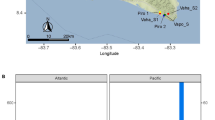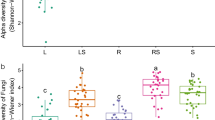Abstract
Archaeal 16S rRNA gene sequences have been found in a variety of moderate-temperature habitats including soil and rhizospheres. In this study, the differences of archaeal communities associated with Scots pine (Pinus sylvestris L.) short roots, different types of mycorrhizospheric compartments, and uncolonized boreal forest humus were tested by direct DNA extraction, polymerase chain reaction–denaturing gradient gel electrophoresis (PCR–DGGE), and sequencing. The results indicated that mycorrhizal colonization of Scots pine roots substantially influence the archaeal community of pine rhizospheres. Colonization of short roots by most mycorrhizal fungi tested increased both archaeal frequency and diversity. Most of the archaeal sequences encountered in mycorrhizas belonged to the phylum Euryarchaeota, order of Halobacteriales. The difference in archaeal diversity between the mycorrhizospheric compartments and humus was profound. Most compartments with fungal components contained euryarchaeotal 16S rRNA gene sequences, whereas a high diversity of crenarchaeotal sequences and no euryarchaeotal sequences were found in forest humus outside mycorrhizospheres.






Similar content being viewed by others
References
Hershberger, KL, Barns, SM, Reysenbach, AL, Dawson, SC, Pace, NR (1996) Wide diversity of Crenarchaeota. Nature 384: 420
Jurgens, G, Lindström, K, Saano, A (1997) Novel group within the kingdom Crenarchaeota from boreal forest soil. Appl Environ Microbiol 63: 803–805
Großkopf, R, Stubner, S, Liesack, W (1998) Novel euryarchaeotal lineages detected on rice roots and in the anoxic bulk soil of flooded rice microcosms. Appl Environ Microbiol 64: 4983–4989
Jurgens, G, Saano, A (1999) Diversity of soil Archaea in boreal forest before, and after clear-cutting and prescribed burning. FEMS Microbiol Ecol 29: 205–213
Simon, HM, Dodsworth, JA, Goodman, RM (2000) Crenarchaeota colonize terrestrial plant roots. Environ Microbiol 2: 495–505
Chelius, MK, Triplett, EW (2001) The diversity of Archaea and Bacteria in association with the roots of Zea mays L. Microb Ecol 41: 252–263
Pesaro, M, Widmer, F (2002) Identification of novel Crenarchaeota and Euryarchaeota clusters associated with different depth layers of a forest soil. FEMS Microbiol Ecol 42: 89–98
Bomberg, M, Jurgens, G, Saano, A, Sen, R, Timonen, S (2003) Nested PCR detection of Archaea in defined compartments of pine mycorrhizospheres developed in boreal forest humus microcosms. FEMS Microb Ecol 43: 163–171
Nicol, GW, Glover, LA, Prosser, JI (2003) Spatial analysis of archaeal community structure in grassland soil. Appl Environ Microbiol 69: 7420–7429
Ochsenreiter, T, Selezi, D, Quaiser, A, Bonch-Osmolovskaya, L, Schleper, C (2003) Diversity and abundance of Crenarchaeota in terrestrial habitats studied by 16S RNA surveys and real time PCR. Environ Microbiol 5: 787–797
Sliwinski, MK, Goodman, RM (2004) Spatial heterogeneity of crenarchaeal assemblages within mesophilic soil ecosystems as revealed by PCR-single-stranded conformation polymorphism profiling. Appl Environ Microbiol 70: 1811–1820
Yrjälä, K, Katainen, R, Jurgens, G, Saarela, U, Saano, A, Romantchuk, M, Fritze, H (2004) Wood ash fertilization alters the forest humus Archaea community. Soil Biol Biochem 36: 199–201
Buckley, DH, Graber, JR, Schmidt, TM (1998) Phylogenetic analysis of nonthermophilic members of the kingdom crenarchaeota and their diversity and abundance in soils. Appl Environ Microbiol 64: 4333–4339
Elshahed, MS, Najar, FZ, Roe, BA, Oren, A, Dewers, TA, Krumholz, LR (2004) Survey of archaeal diversity reveals an abundance of halophilic Archaea in a low-salt, sulfide- and sulfur-rich spring. Appl Environ Microbiol 70: 2230–2239
Purdy, KJ, Cresswell-Maynard, TD, Nedwell, DB, McGenity, TJ, Grant, WD, Timmis, KN, Embley, TM (2004) Isolation of haloarchaea that grow at low salinities. Environ Microbiol 6: 591–595
Sen, R (1990) Intraspecific variation in two species of Suillus from Scots pine (Pinus sylvestris L.) forests based on somatic incompatibility and isozyme analysis. New Phytol 114: 607–616
Giovannoni, SJ, DeLong, EF, Olsen, GJ, Pace, NR (1988) Phylogenetic group-specific oligodeoxynucleotide probes for identification of single microbial cells. J Bacteriol 170: 720–726
Stahl, DA, Amann, R (1991) Development and application of nucleic acid probes in bacterial systematics. In: Stackebrandt, E, Goodfellow, M (Eds.) Nucleic Acid Techniques in Bacterial Systematics, 1st edn., John Wiley & Sons Ltd, Chichester, pp 205–248
Sambrook, J, Fritsch, FE, Maniatis, T (2001) Molecular Cloning: A Laboratory Manual. Cold Spring Harbor Laboratory Press, Cold Spring Harbor, NY
Peters, S, Koschinsky, S, Schwieger, F, Tebbe, CC (2000) Succession of microbial communities during hot composting as detected by PCR-single-strand-conformation polymorphism-based genetic profiles of small-subunit rRNA genes. Appl Environ Microbiol 66: 930–936
Jurgens, G, Glockner, F, Amann, R, Saano, A, Montonen, L, Likolammi, M, Munster, U (2000) Identification of novel Archaea in bacterioplankton of a boreal forest lake by phylogenetic analysis and fluorescent in situ hybridization. FEMS Microbiol Ecol 34: 45–56
Rincón, B, Raposo, F, Borja, R, Gonzalez, JM, Portillo, MC, Saiz-Jimenez, C (2006) Performance and microbial communities of a continuous stirred tank anaerobic reactor treating two-phases olive mill solid wastes at low organic loading rates. J Biotechnol 121: 534–543
Swofford, DL (2003) PAUP*. Phylogenetic Analysis Using Parsimony (*and Other Methods). Sinauer Associates, Sunderland, MA, USA
Nixon, K (2002) WinClada. Version 1.00.08. Published by the author, Ithaca, New York
Hammer, Ø, Harper, DAT, Ryan, PD (2001) PAST: Paleontological Statistics Software Package for Education and Data Analysis. Palaeontologia Electronica 4(1): 9pp http://palaeo-electronica.org/2001_1/past/issue1_01.htm
DeLong, EF (1998) Everything in moderation: archaea as ‘non-extremophiles’. Curr Opin Genet Dev 8: 649–654
Smith, SE, Read, DJ (1997) Mycorrhizal Symbiosis. Academic Press, London, p 605
Timonen, S, Marschner, P (2006) Mycorrhizosphere concept. In: Mukerji, KG, Manoharachary, C, Singh, J (Eds.) Microbial Activity in the Rhizosphere, Springer Verlag, pp 155–172
Timonen, S, Jørgensen, KS, Haahtela, K, Sen, R (1998) Bacterial community structure at defined locations of Pinus sylvestris–Suillus bovinus and –Paxillus involutus mycorrhizospheres in dry pine forest humus and nursery peat. Can J Microbiol 44: 499–513
Strzelczyk, E, Dahm, H, Kampert, M, Pokojska, A, Rozycki, H (1987) Activity of bacteria and actinomycetes associated with mycorrhiza of pine (Pinus sylvestris L.). Angew Bot 61: 53–64
Poole, EJ, Bending, GD, Whipps, JM, Read, DJ (2001) Bacteria associated with Pinus sylvestris–Lactarius rufus ectomycorrhizas and their effects on mycorrhiza formation in vitro. New Phytol 151: 743–751
Timonen, S, Hurek, T (2006) Characterisation of bacterial populations associating with Pinus sylvestris–Suillus bovinus mycorrhizospheres. Can J Microbiol 52: 769–778
Nicol, GW, Tscherko, D, Embley, TM, Prosser, JI (2005) Primary succession of soil Crenarchaeota across a receding glacier foreland. Environ Microbiol 7: 337–347
Acknowledgements
The Maj and Tor Nessling Foundation, Svenska Kulturfonden, University of Helsinki and Academy of Finland are thanked for financial support. Dr. Paula Kristo is thanked for her expert help in sequencing and Dr. Jodie Painter for her constructive comments on the manuscript. We also wish to warmly thank Professor Jari Valkonen for providing us with excellent working environment both in atmosphere and equipment.
Author information
Authors and Affiliations
Corresponding author
Rights and permissions
About this article
Cite this article
Bomberg, M., Timonen, S. Distribution of Cren- and Euryarchaeota in Scots Pine Mycorrhizospheres and Boreal Forest Humus. Microb Ecol 54, 406–416 (2007). https://doi.org/10.1007/s00248-007-9232-3
Received:
Revised:
Accepted:
Published:
Issue Date:
DOI: https://doi.org/10.1007/s00248-007-9232-3




